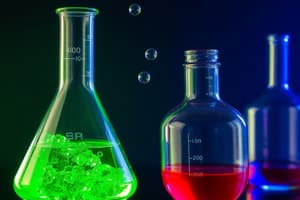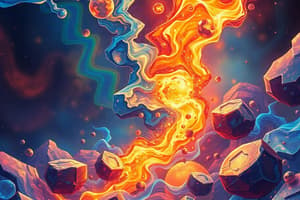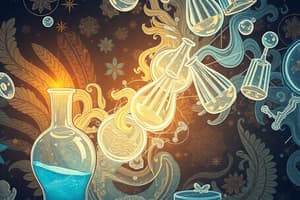Podcast
Questions and Answers
Which of the following describes a change where a substance's shape or size is altered, but its fundamental characteristics remain the same?
Which of the following describes a change where a substance's shape or size is altered, but its fundamental characteristics remain the same?
- Irreversible Change
- Chemical Change
- Nuclear Reaction
- Reversible Change (correct)
What type of change is characterized by the production of new substances with different properties?
What type of change is characterized by the production of new substances with different properties?
- Phase Transition
- Reversible Change
- Physical Change
- Irreversible Change (correct)
Which of the following best describes a physical change?
Which of the following best describes a physical change?
- It always involves a change in color.
- It is usually irreversible.
- It results in the formation of a new substance.
- It alters the arrangement of particles without changing their identity. (correct)
What fundamental principle is observed during a chemical change regarding the mass of the substances involved?
What fundamental principle is observed during a chemical change regarding the mass of the substances involved?
Which of the following observations is a reliable indication that a chemical change has occurred?
Which of the following observations is a reliable indication that a chemical change has occurred?
Which of the following processes is most likely a physical change?
Which of the following processes is most likely a physical change?
Particles are closely packed together and arranged in a fixed pattern. What state of matter is being described?
Particles are closely packed together and arranged in a fixed pattern. What state of matter is being described?
Particles are close together but can move around and slide past each other. What state of matter is being described?
Particles are close together but can move around and slide past each other. What state of matter is being described?
Particles are far apart and move very quickly. What state of matter is being described?
Particles are far apart and move very quickly. What state of matter is being described?
What gas is commonly used to test if exhaled air is the same as inhaled air?
What gas is commonly used to test if exhaled air is the same as inhaled air?
What happens to clear lime water when carbon dioxide gas is bubbled through it?
What happens to clear lime water when carbon dioxide gas is bubbled through it?
Human respiration involves inhalation of oxygen and exhalation of carbon dioxide. What kind of change is the exchange of gases in our bodies?
Human respiration involves inhalation of oxygen and exhalation of carbon dioxide. What kind of change is the exchange of gases in our bodies?
What process causes bread to no longer discolor iodine, indicating a chemical change?
What process causes bread to no longer discolor iodine, indicating a chemical change?
During digestion, what is the role of stomach muscles, acids and enzymes?
During digestion, what is the role of stomach muscles, acids and enzymes?
Mixing baking soda and vinegar results in the production of which of the following?
Mixing baking soda and vinegar results in the production of which of the following?
What properties describe carbon dioxide?
What properties describe carbon dioxide?
What type of change occurs when carbon dioxide gas is transformed into dry ice?
What type of change occurs when carbon dioxide gas is transformed into dry ice?
What is the initial change when heating white granulated sugar?
What is the initial change when heating white granulated sugar?
As white granulated sugar continues to heat, the next observed change is that it:
As white granulated sugar continues to heat, the next observed change is that it:
Continued heating of white granulated sugar leads to the production of specific characteristics. What are they?
Continued heating of white granulated sugar leads to the production of specific characteristics. What are they?
What type of change occurs when a candle burns?
What type of change occurs when a candle burns?
When a transparent glass cup is placed over a burning candle flame, what observation indicates a chemical change?
When a transparent glass cup is placed over a burning candle flame, what observation indicates a chemical change?
What happens when a glass slide briefly touches a candle flame?
What happens when a glass slide briefly touches a candle flame?
What classification of change is associated with burning fireworks?
What classification of change is associated with burning fireworks?
What is a key indicator that a chemical reaction has occurred during the burning of gunpowder in fireworks?
What is a key indicator that a chemical reaction has occurred during the burning of gunpowder in fireworks?
How can one determine if a copper statue's surface being covered with a green substance is a chemical change?
How can one determine if a copper statue's surface being covered with a green substance is a chemical change?
What is the primary component required for iron to rust, leading to its corrosion?
What is the primary component required for iron to rust, leading to its corrosion?
Methods for preventing rust involve preventing the contact of iron with water and air. Which is such a method?
Methods for preventing rust involve preventing the contact of iron with water and air. Which is such a method?
Which of the following culinary transformations involves a chemical change?
Which of the following culinary transformations involves a chemical change?
What chemical process occurs in dough due to yeast, giving the dough a unique smell and making it porous?
What chemical process occurs in dough due to yeast, giving the dough a unique smell and making it porous?
The color change observed when cooking shrimp is an example of what?
The color change observed when cooking shrimp is an example of what?
Which of the following examples represents a chemical change that is beneficial to humans?
Which of the following examples represents a chemical change that is beneficial to humans?
Which of the following is an example of a chemical change that is harmful to humans?
Which of the following is an example of a chemical change that is harmful to humans?
Which of these observations would indicate a chemical change?
Which of these observations would indicate a chemical change?
Which of the following is NOT always an indicator of chemical change?
Which of the following is NOT always an indicator of chemical change?
Which process represents a physical change where no new substance is produced?
Which process represents a physical change where no new substance is produced?
If the concentration of dye molecules decreases, changing the color of water, what kind of change is observed?
If the concentration of dye molecules decreases, changing the color of water, what kind of change is observed?
Flashcards
Reversible change
Reversible change
A change that alters shape or size but not its characteristics.
Irreversible change
Irreversible change
A change that results in a new substance.
Physical change
Physical change
A change in matter that does not create a new substance.
Chemical change
Chemical change
Signup and view all the flashcards
Matter
Matter
Signup and view all the flashcards
Particle
Particle
Signup and view all the flashcards
Arrange
Arrange
Signup and view all the flashcards
Rearrange
Rearrange
Signup and view all the flashcards
Signs of Chemical Change
Signs of Chemical Change
Signup and view all the flashcards
States of Matter
States of Matter
Signup and view all the flashcards
Solid
Solid
Signup and view all the flashcards
Liquid
Liquid
Signup and view all the flashcards
Gas
Gas
Signup and view all the flashcards
Physical change (particles)
Physical change (particles)
Signup and view all the flashcards
Chemical change (particles)
Chemical change (particles)
Signup and view all the flashcards
Mass in chemical change
Mass in chemical change
Signup and view all the flashcards
Carbon Dioxide
Carbon Dioxide
Signup and view all the flashcards
Inhale Oxygen
Inhale Oxygen
Signup and view all the flashcards
Exhale Carbon Dioxide
Exhale Carbon Dioxide
Signup and view all the flashcards
Digestion of Bread
Digestion of Bread
Signup and view all the flashcards
Chemical Changes in Stomach
Chemical Changes in Stomach
Signup and view all the flashcards
Study Notes
Lesson 1: Physical or Chemical Change Vocabulary
- Reversible: Capable of being reversed
- Irreversible: Not capable of being reversed
- Physical change: A change that alters the form or appearance of a substance but does not change it into a new substance
- Chemical change: A change that produces a new substance
- Matter: Anything that has mass and takes up space
- Particle: A minute portion of matter
- Arrange: To place in a particular order
- Rearrange: To change the order or position of something
Matter and Changes
- Matter exists everywhere
- Changes in matter occur constantly
Reversible vs. Irreversible Changes
- Reversible change: Alters a substance's shape or size without changing its characteristics
- Irreversible change: Results in a new substance
Chemical vs. Physical Changes
- Chemical change: Results in new substances and is usually irreversible
- Physical change: Does not produce new substances
Examples of Physical and Chemical Changes
- Physical changes include chocolate melting, wax melting, sugar dissolving, water boiling, puddle evaporating, water condensing, butter melting, ice melting, oil and water mixing
- Chemical changes include bread toasting, candle burning, wood burning, biscuits baking, potatoes boiling, cakes baking
Signs of Chemical Change
- Bubbles are formed
- Color changes occur
- A solid is formed
- Light and heat are produced
- A sweet or foul smell is present
- Loud explosion happens
States of Matter
- Matter exists in three states: solid, liquid, and gas
Arrangement of Particles in Solids
- Particles in a solid are closely packed together
- They are arranged in a fixed pattern
- They vibrate in place
Arrangement of Particles in Liquids
- Particles in a liquid are closely packed
- They can move about and slide past each other
Arrangement of Particles in Gases
- Particles in a gas are far apart
- They move about very quickly
Physical Changes at a Particle Level
- The arrangement of particles changes, but the particles themselves remain the same
Chemical Changes at a Particle Level
- Particles rearrange to form new substances
Conservation of Mass in Chemical Changes
- The mass of the substance does not change before and after the reaction
Lesson 2: Changes Around Us Vocabulary
- Oxygen
- Carbon dioxide
- Swallow
- Chew
Detecting Exhaled Gas
- Clear lime water tests for the presence of exhaled gases
Reaction of Carbon Dioxide with Lime Water
- Carbon dioxide gas makes clear lime water cloudy
- This is a chemical change
Gases Exchanged by Humans
- Inhale oxygen
- Exhale carbon dioxide
- Gas exchange in our bodies represents a chemical change
Digestive System
- Mouth, esophagus, stomach, large intestines, small intestines all digest food
Starch, Bread, and Iodine
- Starch in bread turns iodine blue
- Breaking bread via chewing is a physical change
Enzymes and Bread
- Enzymes in saliva react with the starch in bread
- This is a chemical change
- Chewed bread no longer discolors iodine
Digestion in the Stomach
- Stomach muscles mix food with acids and enzymes
- Acids and gastric juices break down food into absorbable liquids
- This process involves chemical changes
Knowledge Extension: Chemical Reactions
- Mixing baking soda and white vinegar produces carbon dioxide gas
- Carbon dioxide is a colorless, odorless gas, heavier than air, non-combustible, and can extinguish fires
Physical Change: Dry Ice
- Carbon dioxide gas turning into dry ice is a physical change
- Carbon dioxide is used for artificial rain, food refrigeration, carbonated drinks, and fire extinguishers
The Transformation of Sugar
- Heating white sugar creates a new substance
- Sugar melts, representing a physical change
- Melted sugar turns yellow, then darkens, becoming a black solid that emits smoke with a particular scent
- The resulting black solid and scent both qualify as new substances
- Therefore, heating white sugar results in a chemical change
Burning Candle Wax
- Burning candle wax creates new substances
- Placing a clear glass over a candle flame reveals water droplets on the glass
- Briefly holding a glass slide to a candle flame will leave black carbon residue
- Burning candle wax produces new substances, and therefore means it is a chemical change
Fireworks Composition and Reaction
- Fireworks consist mainly of gunpowder
- Burning gunpowder produces new substances like gases
- Reaction emits light and heat, marking it a chemical change
Corrosion of Copper Lions
- Copper lions are cast from bronze alloys
- Green coatings on the surface indicate a change where new green substances are created
- This marks it as a chemical change
Rusting of Iron
- Iron rusts upon prolonged exposure to oxygen and moisture in the air
- Rust is a reddish-brown substance, less durable and easier to erode than iron
- A completely rusted piece of iron can expand in volume by eight times
- Failure to remove rust accelerates corrosion, as it easily absorbs moisture
Preventing Rust
- Preventing rust involves blocking the iron from contacting water and air
- Traditional rust prevention methods include: applying paint, electroplating, creating alloys, greasing, enameling, keeping dry, forming an oxide film, etc.
Examples of Chemical Changes
- Baking cakes using flour and cooking shrimp until red both generate new substances, and are chemical changes
The Chemistry of Baking
- Yeast converts starch into alcohol and carbon dioxide, along with sugar amino acids, organic acids, and lipids
- Lipids give dough its aroma, while carbon dioxide makes the dough porous, fluffy and pliant
The Chemistry of Cooking Shrimp
- Shrimp turns red due to astaxanthin
- Astaxanthin can combine with different forms of protein, and change to other colors
- When protein is damaged, denatured or separated, the color reverts to the original orange-red hue
Helpful and Harmful Chemical Changes
- Beneficial chemical changes: grain fermentation, metal smelting, etc
- Harmful chemical changes: iron rusting, acid rain damaging forests and corroding buildings, etc
Phenomena Accompanying Chemical Changes
- Phenomena: color change (iron rusting), light and heat emission (candle burning), gas production (mixing vinegar and baking soda), precipitate production (mixing milk and vinegar), etc
- Sometimes, these phenomena happen simultaneously
Physical Changes
- Not all color, light, heat, gas, or precipitate-related changes involve new substances
- These examples relate to physical change: light bulb emitting light, sediment settling, water boiling, ink dilution
Studying That Suits You
Use AI to generate personalized quizzes and flashcards to suit your learning preferences.




